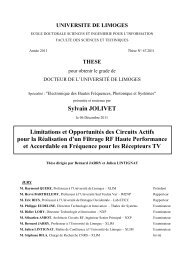Etude et conception de structures de filtrage actif radiofréquence ...
Etude et conception de structures de filtrage actif radiofréquence ...
Etude et conception de structures de filtrage actif radiofréquence ...
Create successful ePaper yourself
Turn your PDF publications into a flip-book with our unique Google optimized e-Paper software.
Résumé<br />
Ces travaux <strong>de</strong> thèse consistent à concevoir <strong>de</strong> nouvelles topologies <strong>de</strong>vant remplacer<br />
les circuits <strong>de</strong> <strong>filtrage</strong>s classiques par <strong>de</strong>s solutions actives <strong>et</strong> adaptables pour augmenter les<br />
performances <strong>et</strong> réduire les coûts. Les circuits intégrés en silicium sont développés <strong>et</strong> réalisés<br />
avec la collaboration industrielle du Centre d'Innovations RF <strong>de</strong> PHILIPS Semiconducteur à<br />
CAEN. A partir d'une recherche bibliographique sur le <strong>filtrage</strong> <strong>actif</strong>, quatre axes topologiques<br />
sont sélectionnés <strong>et</strong> développés pour aboutir à quatre <strong>conception</strong>s <strong>de</strong> circuits intégrés dont<br />
<strong>de</strong>ux sont réalisés. La première topologie est basée sur le principe <strong>de</strong> l'inductance active. Ce<br />
concept est très avantageux en terme <strong>de</strong> surface occupée <strong>et</strong> présente un balayage important en<br />
fréquence centrale. Ce filtre n'a pas été réalisé à cause <strong>de</strong> sa consommation, <strong>de</strong> son facteur <strong>de</strong><br />
bruit élevé ainsi que sa linéarité limitée. La <strong>de</strong>uxième topologie, basée sur le principe du filtre<br />
LC, a été réalisée. Ce circuit différentiel est composé <strong>de</strong> quatre résonateurs couplés réalisés à<br />
l'ai<strong>de</strong> <strong>de</strong> transistors NMOS afin <strong>de</strong> constituer un filtre du quatrième ordre.<br />
Le troisième circuit qui a également été réalisé est un filtre LC différentiel <strong>de</strong> premier ordre. Il<br />
se compose d'un amplificateur, d'un résonateur LC, d'un convertisseur d'impédance <strong>et</strong> d'une<br />
résistancenégative. Ce filtre a nécessité une analyse électromagnétique très rigoureuse.<br />
Finalement, un quatrième circuit est présenté comme une perspective à ces travaux <strong>de</strong> thèse.<br />
Ce filtre LC intégré utilise un transformateur passif composé <strong>de</strong> trois inductances, sans circuit<br />
<strong>de</strong> compensation <strong>de</strong> pertes qui dégra<strong>de</strong> généralement la linéarité totale du filtre.<br />
Summary<br />
This thesis work consists in <strong>de</strong>signing new topologies in or<strong>de</strong>r to substitute the<br />
traditional passive filtering circuits by active ones. These tunable solutions increase the<br />
performances and reduce the costs. Silicium integrated circuits are <strong>de</strong>veloped and realized by<br />
an industrial collaboration of RF Innovations Center PHILIPS Semiconductor at CAEN.<br />
Based on a bibliographical research of active filtering, four topological axes are selected and<br />
<strong>de</strong>veloped to lead to four integrated circuit <strong>de</strong>signs, among which two are realized. The first<br />
topology is based on the active inductance principle. This <strong>de</strong>sign is very advantageous in term<br />
of occupied surface and presents an important centre frequency tuning band. This filter was<br />
not realized because of its consumption, of its high noise figure and its limited linearity. The<br />
second topology is based on the LC filter principle. This realized differential circuit is<br />
composed of four coupled resonators based on NMOS transistors in or<strong>de</strong>r to constitute the<br />
fourth or<strong>de</strong>r.<br />
The third circuit which has also been realized is a first or<strong>de</strong>r LC differential filter. It is<br />
composed of an amplifier, an LC resonator, an impedance converter and a negative resistance.<br />
This filter has required a very rigorous electromagn<strong>et</strong>ic analysis. Finally, a fourth circuit is<br />
presented as a perspective to this thesis work. This LC integrated filter uses a passive<br />
transformer ma<strong>de</strong> up of three inductances, without any compensating n<strong>et</strong>work, which<br />
generally <strong>de</strong>gra<strong>de</strong>s the total linearity of the filter.
















